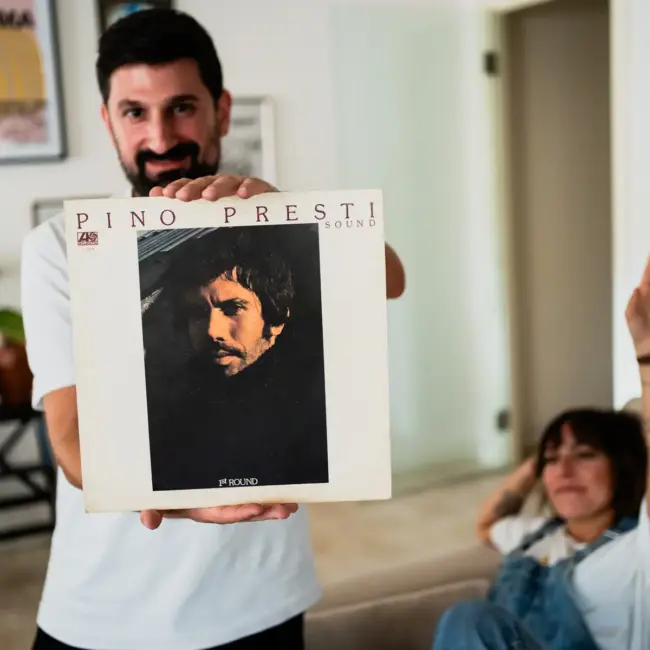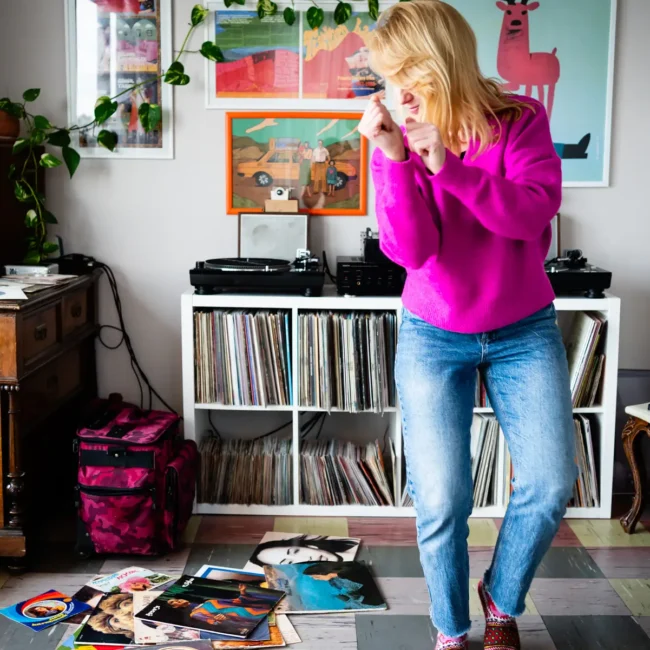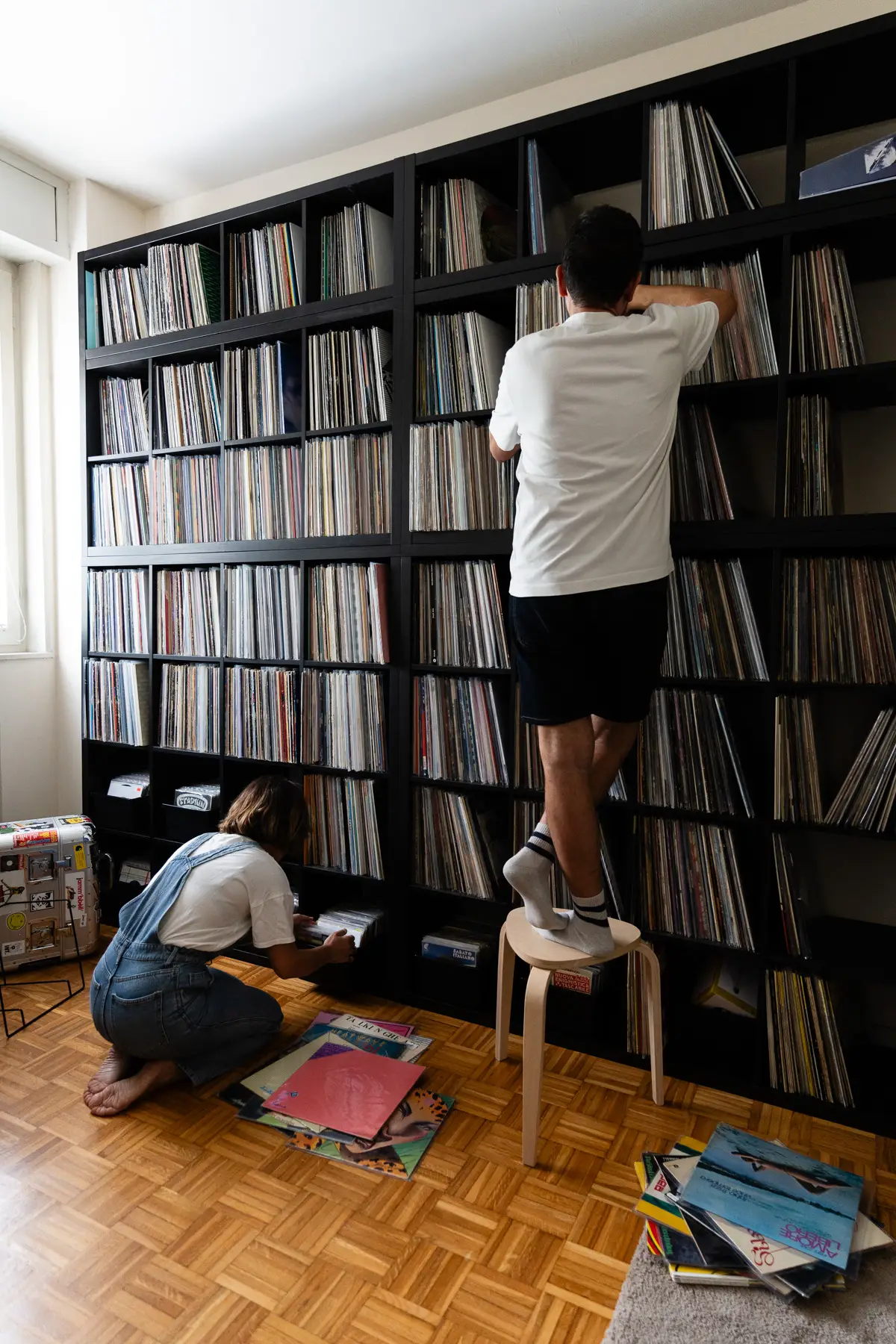
Gio & Vale
Raregems
Unusual Unknowns
BY kaitlin venneman
The only thing better than one record collection? Combining two with your equally music-obsessed partner.
The only downside?
“The paranoia that arises when a record gets lost!”
Gio and Vale are longtime friends turned romantic record collectors and DJ duo, most known by the joint name Raregems. The Italian pair curated a radio show called Storie di Digging on Radio Raheem, an online independent radio devoted to deep dives on various artists, podcasts, and plenty of cosmic sounds, where they interviewed fellow diggers to share the “stories that emerged and renewed through vinyl matter.” They also operate an extensive Discogs, complete with a wealth of disco, funk, and soul records fit for any music aficionado in Italy with some euros to spare.
But their true musical purpose lies within their name: an unparalleled devotion to discovering unique, unusual, and magical sounds, “we try not to put boundaries on our collection, driven by curiosity to unearth records from every corner of the planet.”
The journey of each album is an apparent priority in how the pair approach their DJ sets too, “DJing for an audience is just the tip of the iceberg of an experience that starts with building the story, the journey you want to tell…The goal is to spread a piece of our research journey each time that makes people break out and open their minds.” This has led them to performances across Europe, hand-blended vinyl sets with coffee collaborators, and a social media presence that shares their love of the unique records they come across.
Their commitment has paid off—because of their revelations, the pair are able to trace a careful lineage of the sounds that inspire them, from their Italian background to their current obsession with African and Latin beats, being careful to always prioritize the unheard and unknown records. For them, it’s a matter of historical revelation and dedication to finding something new, “our love for the unknown, underrated, and off-the-radar records is a mission…we’re here to give them the spotlight they’ve always deserved. It’s all about uncovering those hidden musical treasures.”
“Music is the common thread in our relationship — it’s with us every moment of the day and brings us even closer.”
—Raregems
What is your first memory involving music?
Vale: It was 1997, and at the time I was living with my mother in Goro, a small town on the Po River Delta. During lunch one day, we were in a village tavern with my mother’s colleagues, and I headed to the cash register. Suddenly, I was in awe of the video playing on the Mivar on the wall—MTV was playing “Around The World,” by the futuristic Daft Punk. I was used to listening to Lucio Dalla, Battisti, or Mina at home so that new sound totally opened my mind. Probably not my first memory of music, but certainly the most vivid and meaningful one.
Gio: I remember as a child, sneaking into my older teenage sister’s room to rummage through her “precious” cassette tapes. I would insert them into my father’s gray Walkman—Red Hot Chili Peppers, The Cranberries, Carmen Consoli. I don’t remember exactly what year it was, but I remember the smell of cigarettes that she snuck with her deskmate.
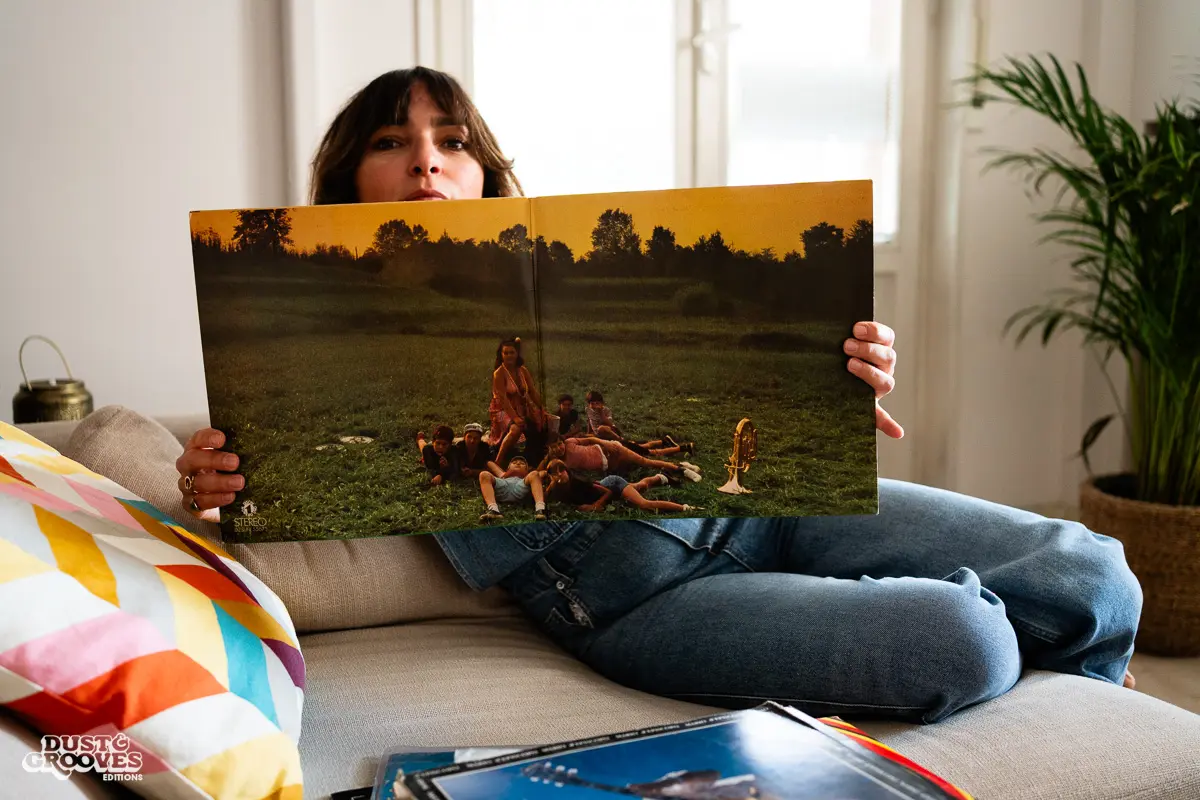
Lucio Battisti – Anima Latina. “It’s probably his most ambitious, complex, and multifaceted record — a true ’70s fusion of Latin sounds and rhythms with progressive modes of expression. Tracks such as ‘Abbracciala Abbracciali Abbracciati,’ ‘Natural Separation,’ and ‘Anima Latina,’ which gives the album its title, reveal new layers with every listen. Battisti intentionally made some lyrics difficult to understand as a way to make the listener’s role more active.”
How did you two meet? What part has music played in your relationship?
We have known each other for many, many years since our college days, and as friends, we have both always had a passion for music from the first parties we organized together. Music is the common thread in our relationship — it’s with us every moment of the day and brings us even closer.
What does being a record collector mean to you?
For us, being collectors means preserving certain kinds of music and artists for the future. Through our search for forgotten and little-known records, we have the opportunity to safeguard music and connect these artists to the history, traditions, and social culture of their countries. In this way, we see ourselves as archivists.
It’s all about collecting fragments of interwoven stories, each recorded groove is a journey. The idea is not to stop at what we listen to or what the classical media offers us every day, but to go deeper and discover ourselves, our own tastes and attitudes, through searching for records. We believe that the record is the perfect medium to explore distant places and eras while standing still in the same place today. It’s something that is also very much tied to personal characteristics such as insatiable curiosity, a desire to broaden one’s horizons and delve into unique cultures!
What genres do you specialize in, and how did you get into them?
We try not to put boundaries on our collection, instead letting curiosity drive us to unearth records from every corner of the planet. To date, our collection is probably most influenced by the currents of Black music and groove, but it extends far beyond that. We consider ourselves eclectic and curious collectors.
Do you generally find yourself gravitating away from Italian music?
To continue reading this interview we humbly ask you to consider supporting Dust & Grooves by becoming a paying premium member.
Italian music represents a starting point, but our approach to digging has no cultural or space-time barriers. So yes, we often find ourselves gravitating away from Italian genres in the direction of pure discovery and research toward new sounds, sub-genres, and distant musical styles. Vinyl is a tool of knowledge for us, an incredible journey across continents and their histories and cultures.
“Through our search for forgotten and little-known records, we have the opportunity to safeguard music and connect these artists to the history, traditions, and social culture of their countries.”
A lot of the records you showed off were Italian library music. What is it about this fusion of music and storytelling that you are drawn to? What led you to collect and research your Italian library?
In Italian library music, there was no compromise and there was little desire to imitate others. A lot of its purpose was to experiment and approach unexplored sounds. The political-social climate of the 1960s, with the student, worker, and feminist struggles, saw the consolidation of the committed songs of the great singer-songwriters. Meanwhile, the library was a transversal phenomenon that more or less clandestinely exploded in those years. It was generic music, intended mainly for huge audio catalogs available to RAI (European television and radio) programmers.
It was probably the non-specific destination that was the driving force behind the expressive freedom of this music scene. It embraced multiple worlds, from the spaghetti soul and funk of Feelings by Stefano Torossi and Desert by Antonio Vuolo and Elio Grande to the lounge revival of albums Polinesia and Continente Nero by Piero Umiliani. Library music even included the electronic and abstract Insight Modulation by Zanagoria, and the easy listening of Alessandroni’s masterpiece, Prisma Sonoro. Those were the library years and they smelled of the future. They were the years of imaginary scenery, landscapes, social problems, and escapism.
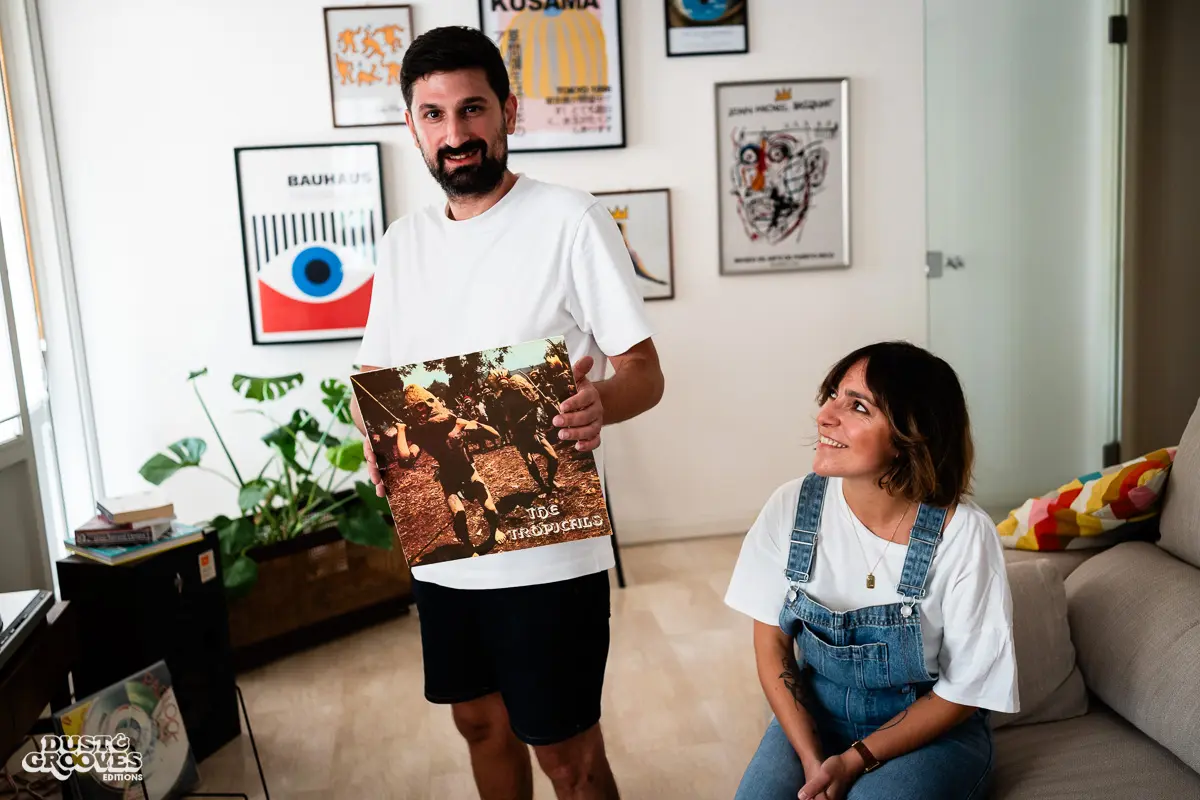
The Tropicals – Urubamba. “The Tropicals, Giancarlo Bigozzi (Ginazzi) and Oscar Rocchi (Chiarosi), are a duo with deep jazz roots. Ginazzi, a saxophonist, has collaborated with jazz legends like Giorgio Gaslini and Frank Sinatra, while Chiarosi is a pianist and composer active since the early 1970s. Together, they crafted an experimental jazz-funk album with Afro influences in 1972. We had been searching for this record for a long time, drawn to Italian experimental records that go beyond traditional library music. This album is a prime example of visionary work from that period. One day, to our astonishment, Paolo Scotti, an expert in Italian soundtracks and library records, offered us a mint-condition double copy for a swap. We didn’t hesitate to make the exchange!”
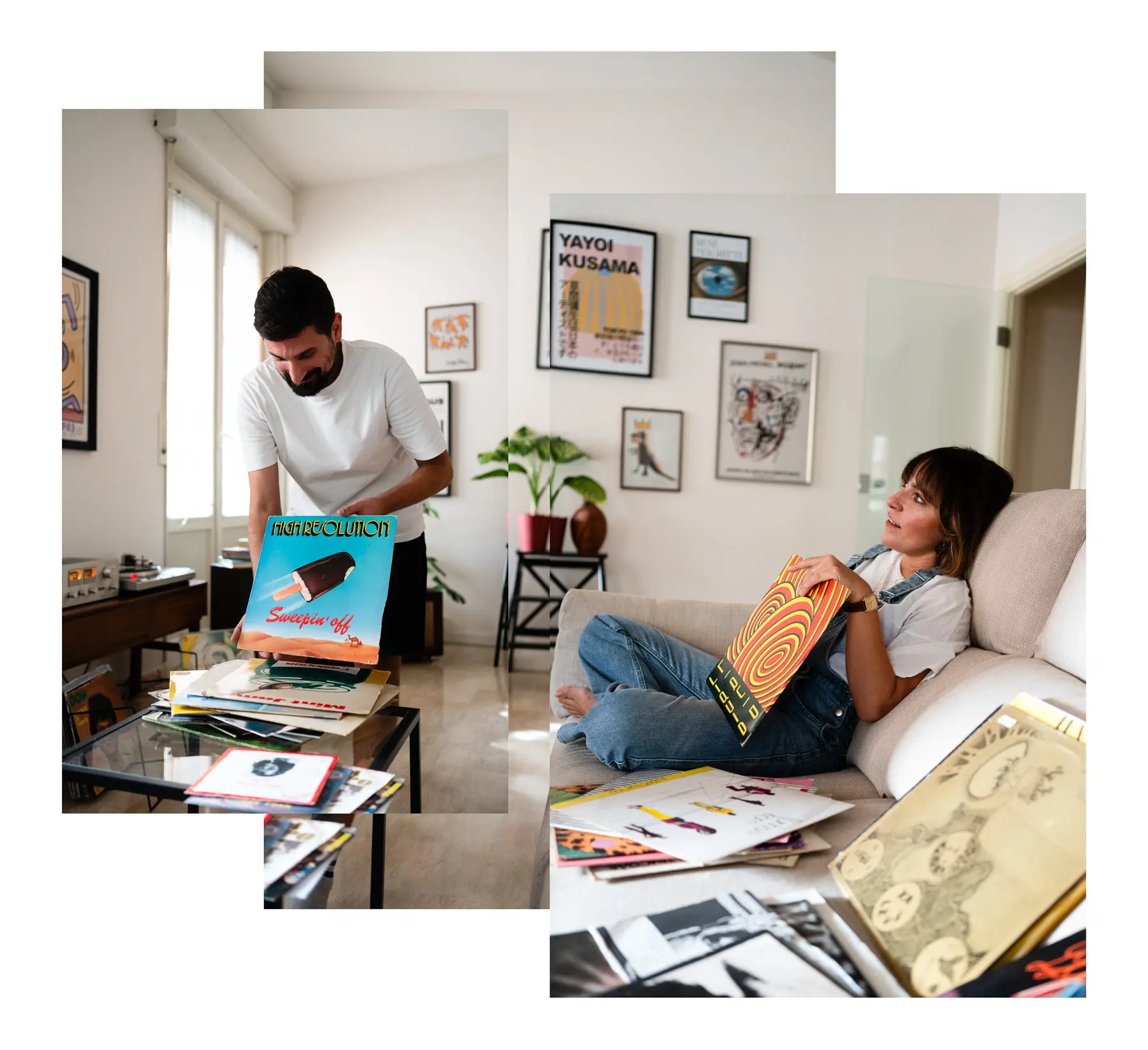
High Resolution – Sweepin’ Off / Liquid Liquid – Optimo. “Unintentionally, we discovered we had two records from 1983 in the same photo. One represents Italy’s Italo disco with a nod to new wave, while the other features the almost obscure no-wave band Liquid Liquid, pioneers of the alternative movements that would dominate the 1980s. New York of that era is a huge inspiration for us—a time of absolute freedom of expression and cross-pollination. There was a real sense of community and sharing, not just among different music genres but across various art forms, like installations, graffiti, and short films.”
What is the most striking thing about the Italian record scene to you?
For us, the Italian discography represents the root of our musical culture, the foundation on which we then built our path of influences and discoveries. If we now love disco made in the US, it’s because we started with disco band Change, produced by the Italian Mauro Malavasi in 1980 between Bologna and New York, it’s because of the productions of the Roman disco-boogie scene that produced “Sweepin’ Off” by High Resolution. If we now look for groove in a record, it is thanks to Pino Presti’s 1st Round and the spaghetti sound; bossanova is because in 1963 the Fonti label produced “Se Io Potessi” by Daniela Casa, or through the Afrobeat on the 1972 album Urubamba by The Tropicals. If we approached a certain type of electronic and new wave, it is thanks to the Italo-disco scene that marked an era and conceived masterpieces such as Gaznevada’s “I.C. Love Affair,” Mr. Flagio’s “Take a Chance,” or Casco’s “Cybernetic Love,” to name a few. These are just a few examples of the multiplicity of sounds that were the starting point for us.
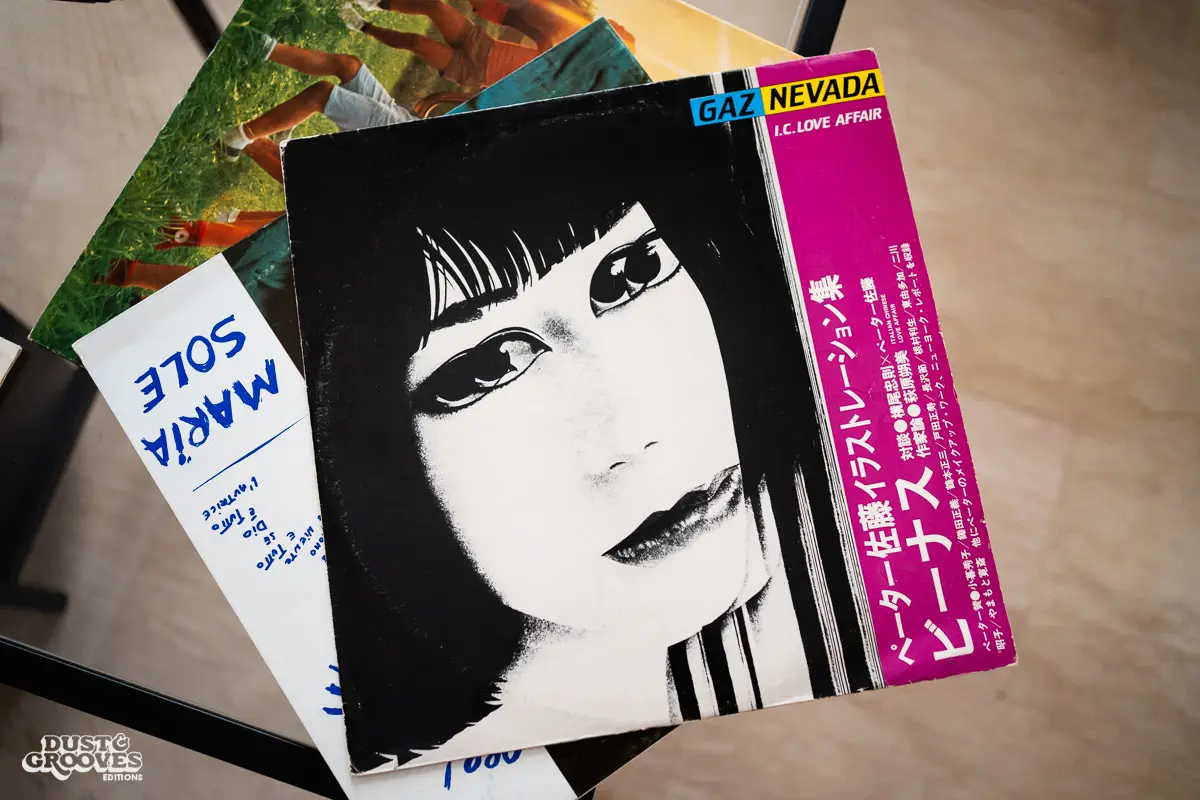
Gaznevada – “I.C. Love Affair”. “While Italo disco’s origins trace back a few years earlier, ‘I.C. Love Affair’ stands as a seminal track in the genre. It holds a place in our top five Italo disco records of all time, not just for its musical composition, but also for its striking cover art. The Chinese lettering and hypnotic imagery transport listeners to the Oriental world, echoing the aesthetics of Japanese city pop and new wave.”
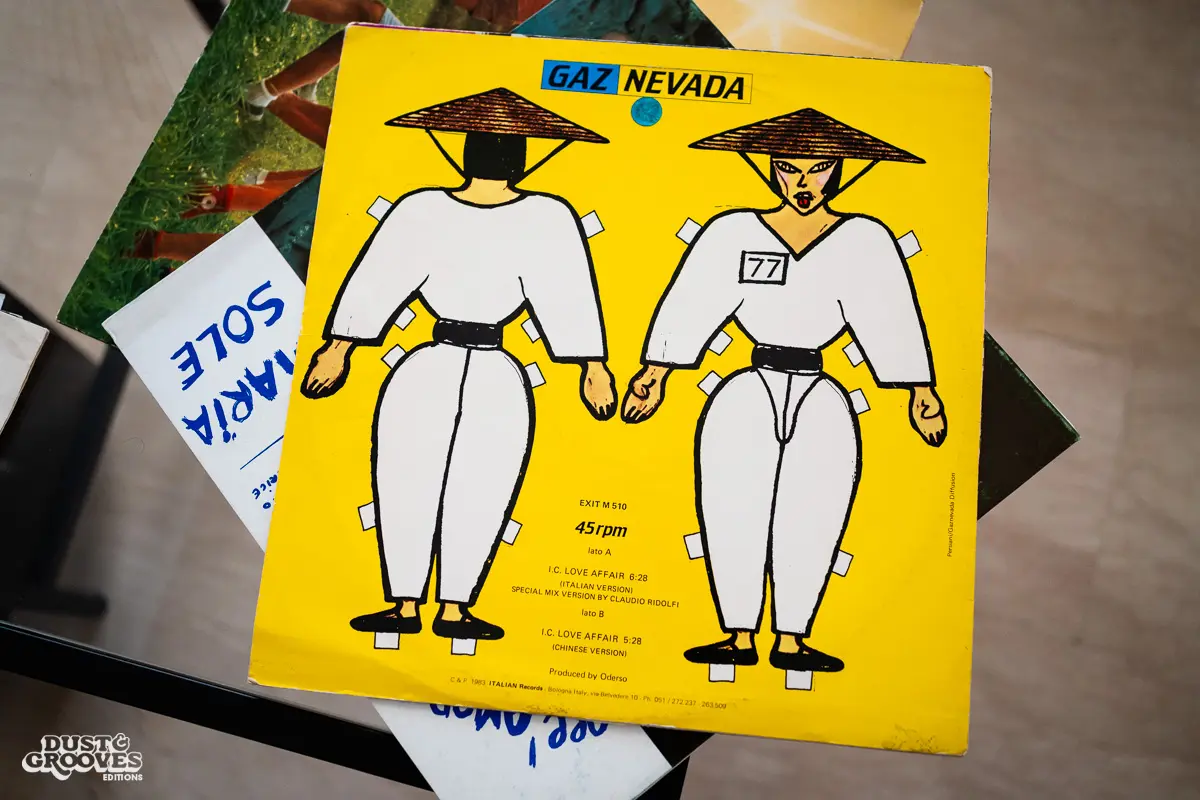
Gaznevada – “I.C. Love Affair”
“The New York of [The 80s] is a huge inspiration for us, a time of absolute freedom of expression and cross-pollination. There was a real sense of community and sharing, not just among different music genres but across various art forms like installations, graffiti, and short films."
Tell us about this Daniela Casa record? Where did you find it
Daniela Casa’s record is an iconic symbol of a golden era in Italian music—a time when genres like easy listening and bossa nova blended effortlessly. We’ve always had a special place in our hearts for bossa nova, a genre that captured an unforgettable moment in time when musicians, singers, composers, and poets all came together to reimagine Brazilian music and culture. Finding this record was more than just a lucky dig, it’s part of the larger web of connections we’re always talking about. It came to us through an exchange with an Italian collector.
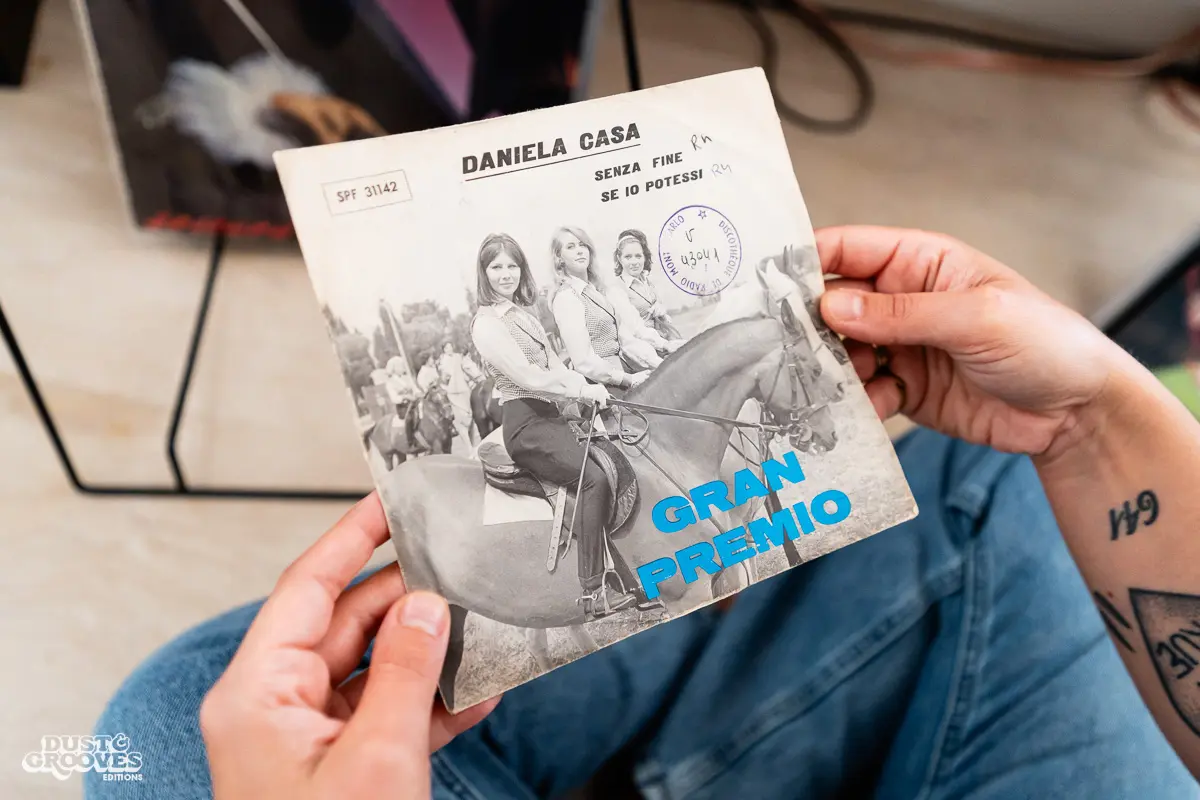
Daniela Casa – “Se Io Potessi”. “Daniela Casa, known by her pseudonym Elageron, was an Italian singer and composer who carved out an unconventional path in the music industry. Active primarily between the 1960s and early 1980s, Casa’s career began in Italian pop music before taking a dramatic turn in the 1970s toward electronic, experimental, and psychedelic sounds for radio and television. This single marks the early stage of her artistic journey. It holds a special place in our hearts as it encapsulates a pivotal period in our country’s rebirth during the 1960s—an era characterized by a cosmopolitan, dreamy Italy. Musically, it represents an early fusion of ‘musica leggera’ with bossa nova, showcasing the innovative spirit of the time.”
Daniela Casa – “Se Io Potessi”. “The holiest of the holy grails in our possession. We treat it like our baby.”
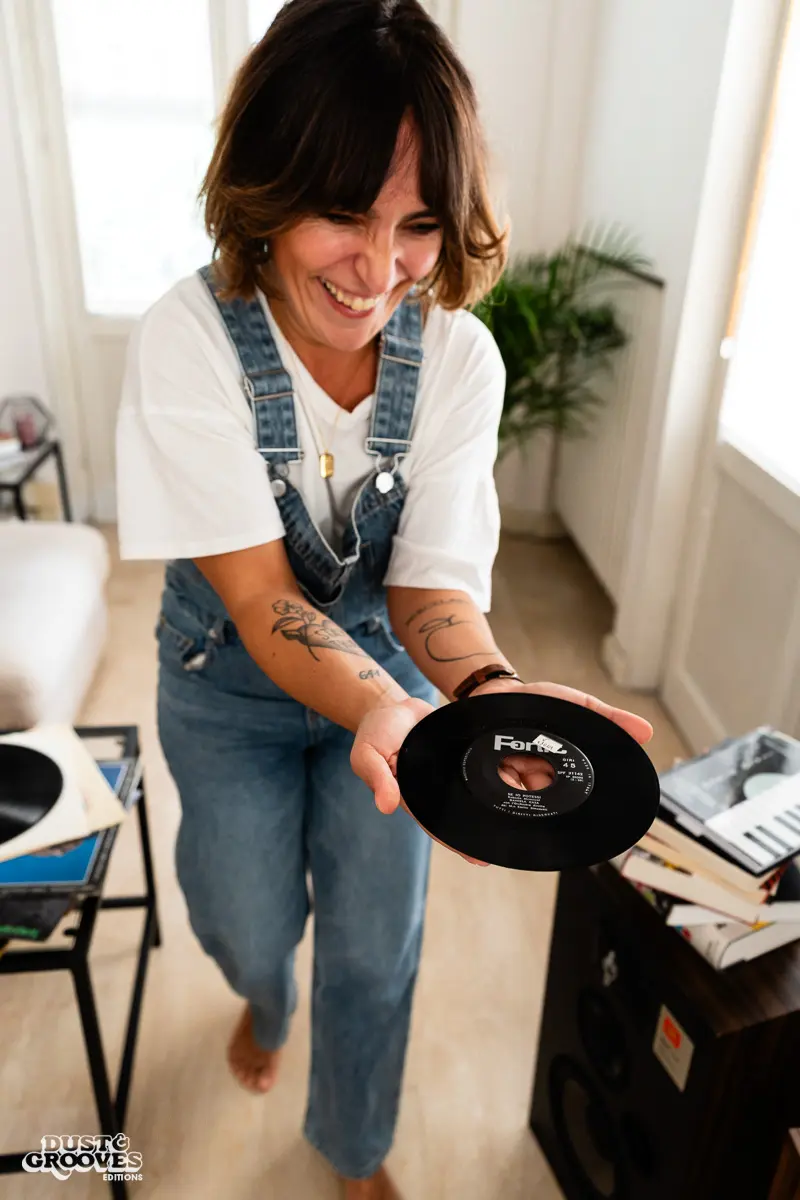
Could you tell me more about your radio show, and what you’ve learned in doing it?
Storie di Diggin’ is all about diving deep into the world of vinyl—the connections, memories, experiences, and emotions that come with the hunt and discovery of music on wax. Our vibe is eclectic, adventurous, and always on the lookout for the next hidden gem. Each episode of our radio show is a snapshot of that endless journey through sound.
In the past year, we’ve taken it up a notch, digging into something even more powerful: the human connections that music and vinyl collecting spark. We’ve invited passionate collectors and vinyl enthusiasts to share their personal stories, their deep-rooted love for music, and how the vinyl community has shaped their lives. Our goal is to create an authentic conversation that inspires and connects—celebrating the one-of-a-kind culture of vinyl lovers everywhere.
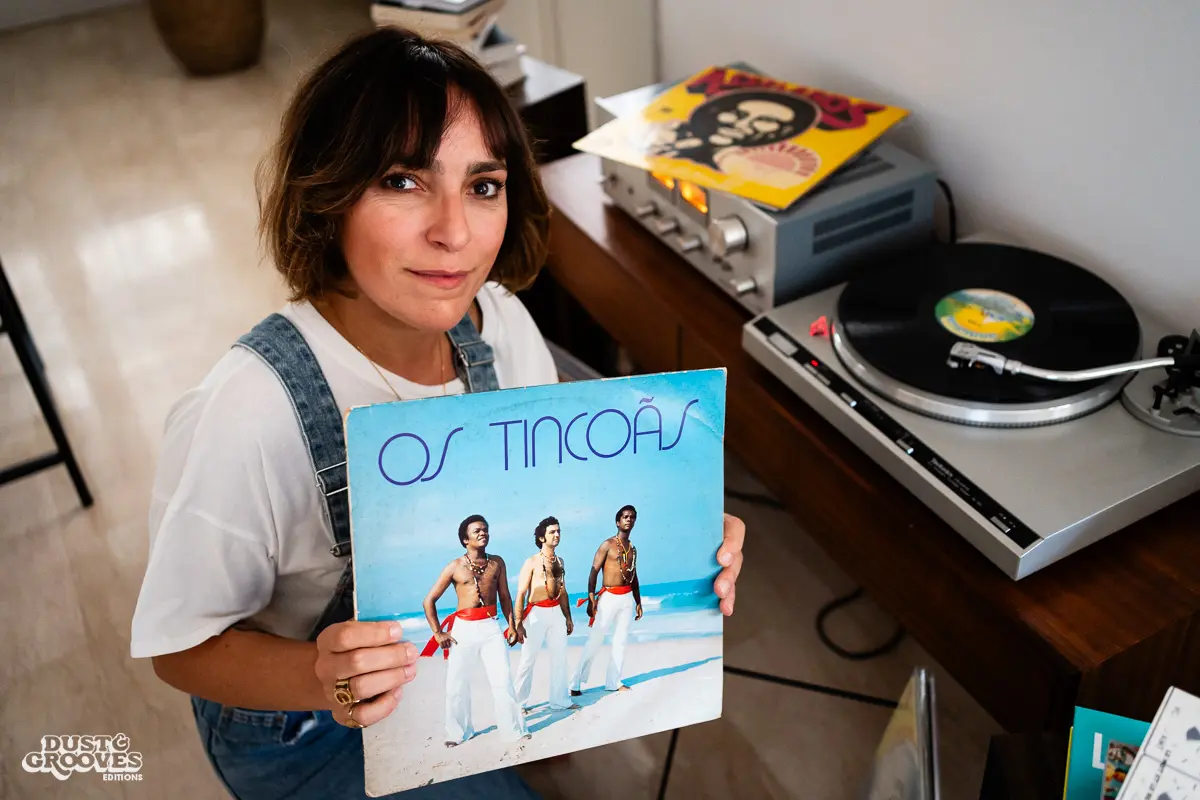
Os Tincoãs – Self-titled. One of the most captivating Brazilian records of the 1970s, Os Tincoãs channels Afro-Bahian spirituality through rich vocal harmonies and deep, ritual-like rhythms. Each track feels alive—a testament to the culture and faith of the Recôncavo Baiano. We searched for this record for years; it wasn’t easy to find, especially from across the ocean in Italy. Looking at this photo reminds us of that determination—when a record captures our hearts, we’ll chase it anywhere.
In regards to unearthing hidden gems, what is the most surprising or unique record you’ve found in your search?
We really have so many records we could talk about—so many! Since the early years of digging, we’ve been drawn to exploring subgenres of Latin cultures, including Panama, islands like Trinidad, Barbados, and Guadeloupe, as well as Peru, Suriname, Ecuador, Brazil, and sounds from Africa.
For example, from Panama, the single “Socca Salsa” by Grupo Ebony, especially the track “Afrollano,” is a mix of soca, salsa, and disco. There’s also the Guadeloupean Self-titled Ka Lévé, an album that mixes fusion, jazz and Gwo Ka, the Ecuadorian Grupo Deluxe with the track “Quiero,” or disco by Trepidant’s, a Brazilian group that conceived an electronic track entitled “Robot.” From Ivory Coast, there are Révélations 82 by Les Asselards, who conceived a funk and afro-beat disco album while preserving an infinite spirituality…and so on.
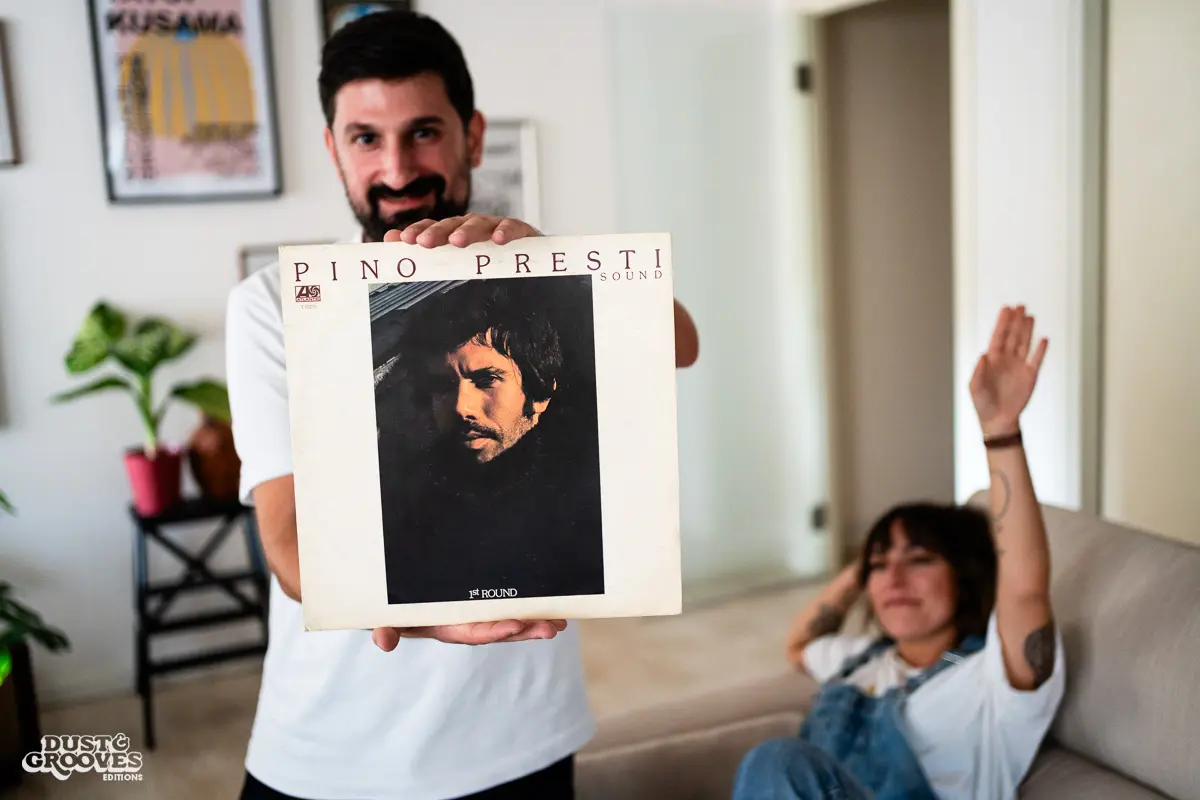
Pino Presti Sound – 1st Round. “Pino Presti is a renowned Italian bassist, multi-instrumentalist, arranger, composer, conductor, and record producer, with a significant impact on Italian TV music. He’s celebrated as one of Italy’s foremost arrangers and conductors. Presti pioneered the Fender Jazz Bass in Italy, beginning his career as a singer and bass player. This record is pivotal for us, as it marks the inception of a musical era we’ve extensively researched and devoted a substantial part of our collection to: Italian disco-funk.”
Further Adventures in Record Collecting
Dust & Grooves Vol. 2
Raregems and 150 other great collectors are featured in the book Dust & Grooves Vol 2: Further Adventures in Record Collecting.
Do you have any favorite stories of digging for a record in the wild? Or is most of your digging done online these days?
We could write a book about our adventures related to digging. We definitely prefer physical digging to online digging, perhaps accompanied by a portable turntable to fully enjoy the search experience without being swayed by the information inherent in the record and instead being captivated or not by the sounds. Undoubtedly, however, online digging has its upsides, like more info on releases, and a wide range of searches by genre, country, and year of release.
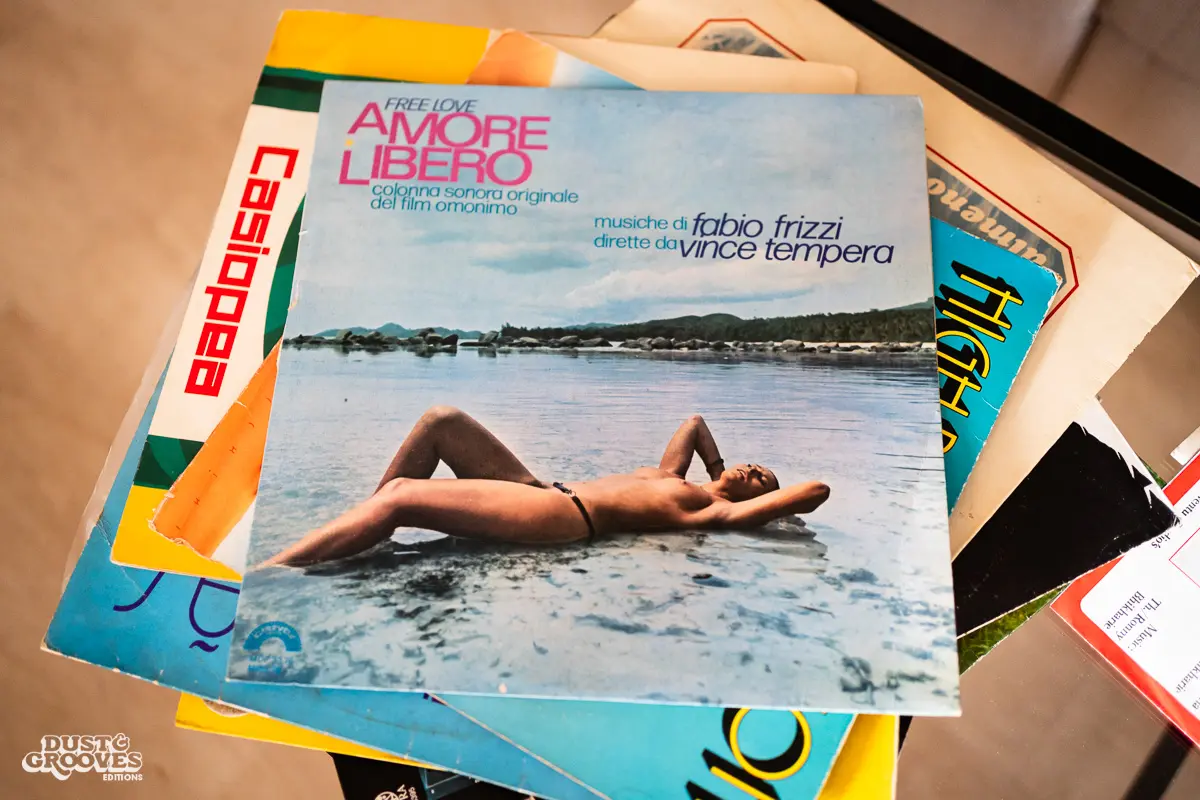
Fabio Frizzi – Amore Libero. “The story behind our discovery of this record is, without a doubt, the luckiest digging tale we’ve ever experienced. It was a Sunday in July, and during a bike ride in search of a cool spot in the city, we stumbled upon a parish market. Amidst a scatter of second-hand objects, old photographs, embroidered doilies, and porcelain mugs, we found a pile of records at the back, all covered in dust. They were all classical music, except for one: Amore Libero, an original Cinevox pressing from 1975. What a lucky Sunday!”
Among the many digging stories, the first that comes to mind is during a hot July Sunday in Parma. We were headed to a bookstore when we casually stumbled upon a small parish market, where, nestled in a small wooden box among dusty classical music records, we unearthed two milestones of Italian music: Fabio Frizzi’s Amore Libero, and an Oscar Prudente record.
Another time, we were in Amsterdam looking for consolation from the last-minute cancellation of the Record Planet Fair. We managed to get the garage doors of an acquaintance seller based in Amsterdam to open, and among the dust of the rusty shelves here, our consolation prize popped out: China Burton’s “You Don’t Care (About Our Love).”
Lastly, we were waiting for the train in Salerno to return to Parma when we dropped by the depot of an old acquaintance. There, in the back of his van was a cassette full of dead stock from an old record store. The first: Marcos Valle. The second: Milton Nascimento. And the third: Gal Costa! Bingo!
“Our goal is to create an authentic conversation that inspires and connects—celebrating the one-of-a-kind culture of vinyl lovers everywhere.”
What is it about vinyl? Why do people still collect records while almost all music is available online?
Listening to music on vinyl is a ritual, an act of love, a delicate procedure of carving out an intimate or shared listening moment in a world going at the speed of light, and with a growing disposable music culture. The discussion is not about which medium is better. It’s about the experience attached to it.
What tips do you have for people just starting out as a record collector?
Have an open mind and be open to different genres, listen a lot and don’t be guided by trends or the market value of a record, which can often vary, but by personal taste. And yes, it will be an unforgettable love story.
The discussion is not about which medium is better. It’s about the experience attached to it.
That Silvana Simone record is beautiful. What drew you towards it?
Silvana Simone might be a bit of a hidden gem in the world of Italian music, but her voice is absolutely magnetic. Her debut album Almeno Tentare, released in the ’80s, was followed over a decade later by L’Utopia Ti Cingerà La Vita. Not much is known about Silvana, except that she was a passionate pacifist and activist—but what really drew us in was the raw power and emotion in her voice. And if you haven’t heard the track “Dimensione Ritmo,” you’re missing out. It’s a whole vibe on its own.
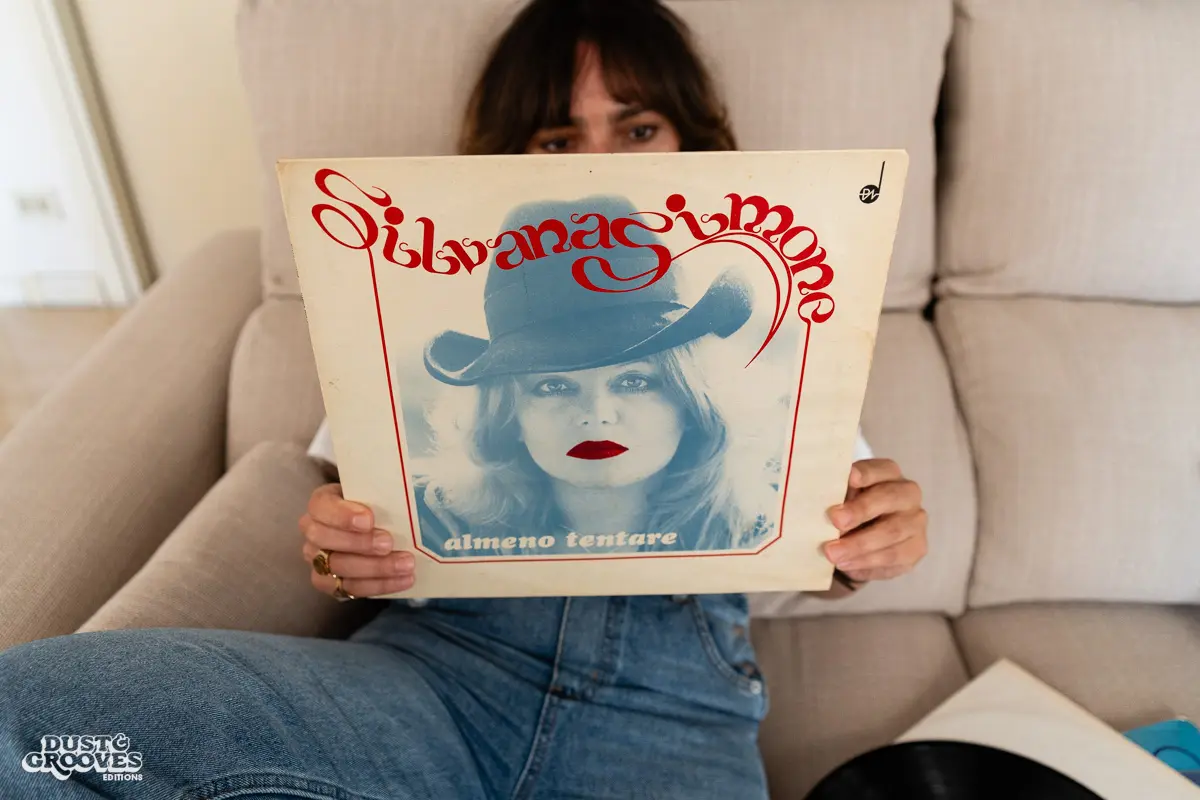
Silvana Simone – Almeno Tentare. Debut album by Silvana Simone, a semi-unknown artist from the Italian underground scene of the early 1980s. “‘Dimensione Ritmo’ is, for us, the most captivating track on this LP: enveloping percussion and dreamy rhythms, with Simone’s voice—its irregular high notes propelling us into a new listening dimension.”
What specific sounds, artwork, or conditions do you look for in a record when you are digging?
More than a sound we look for a feeling in the record, a vibe that makes you immediately know that the record will be yours, hard to explain!
Can you try explaining? What kind of magical moments have you had while listening to a record for the first time?
It is precisely in records like those mentioned earlier that we experienced that immediate and unexplainable feeling, a surprise effect that makes you leap from your chair and feel that that record is there waiting for you. Perhaps this feeling also has to do with a personal path that directs us toward certain sounds, or perhaps with memory that unconsciously influences current tastes and choices. Despite what the name Raregems suggests, we are in search of what is defined as rare not because of the value, but because of the emotions that arise from it.
You seem to have a preference for outsiders, from the punk Maria Sole to the absurd Fantasy Rock. What connects you to these unusual records?
Our love for the unknown, underrated, and off-the-radar records is a mission. We’re driven by the thrill of discovering unheard sounds, and piecing together the unwritten history of records that represent lost subcultures. These are the albums that didn’t get the attention they deserved or were simply forgotten over time, and we’re here to give them the spotlight they’ve always deserved. It’s all about uncovering those hidden musical treasures.
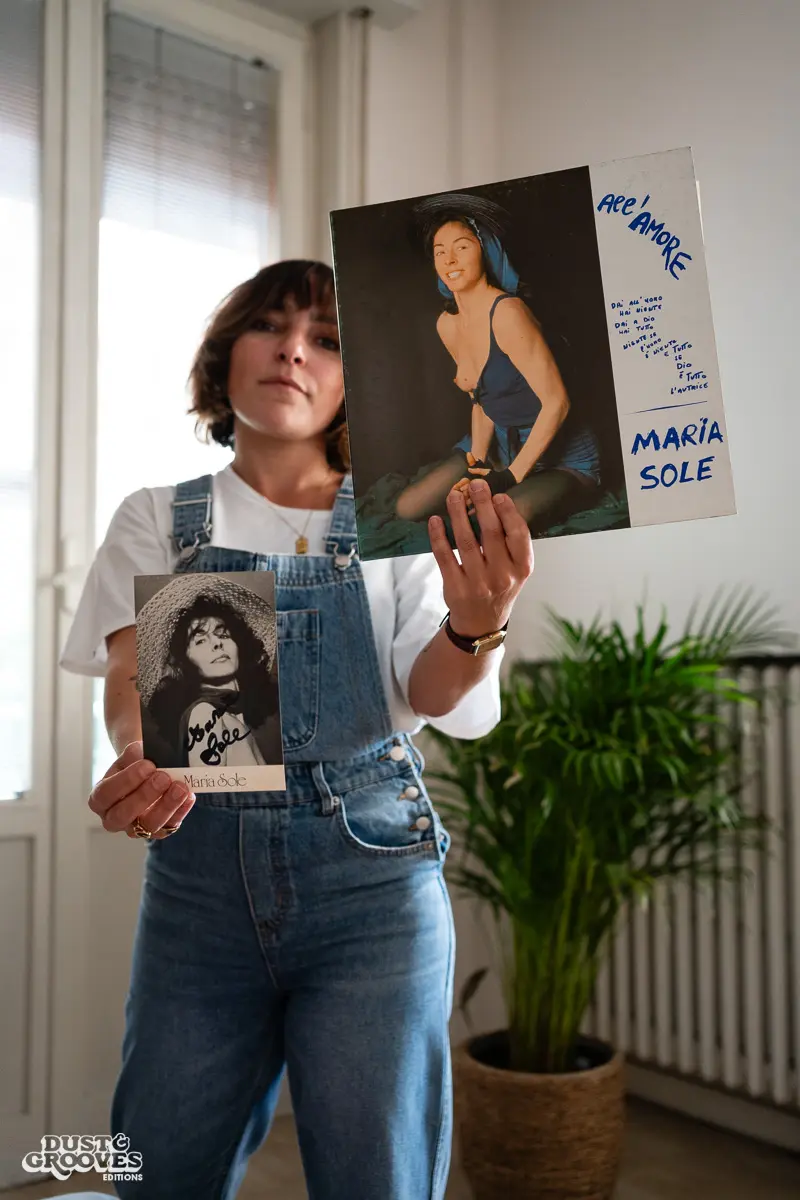
Maria Sole – All’amore. “The second album by the artist, pressed by the Archivak label, was probably owned by her and her husband, Armando Stula. Maria Sole is an innovative and controversial figure; she played a key role in inspiring the Italian post-punk and outsider scene. We had been after this cult album for several years and finally found it thanks to dead-stock copies in Milan. We were fascinated by this album from the very first listen.”
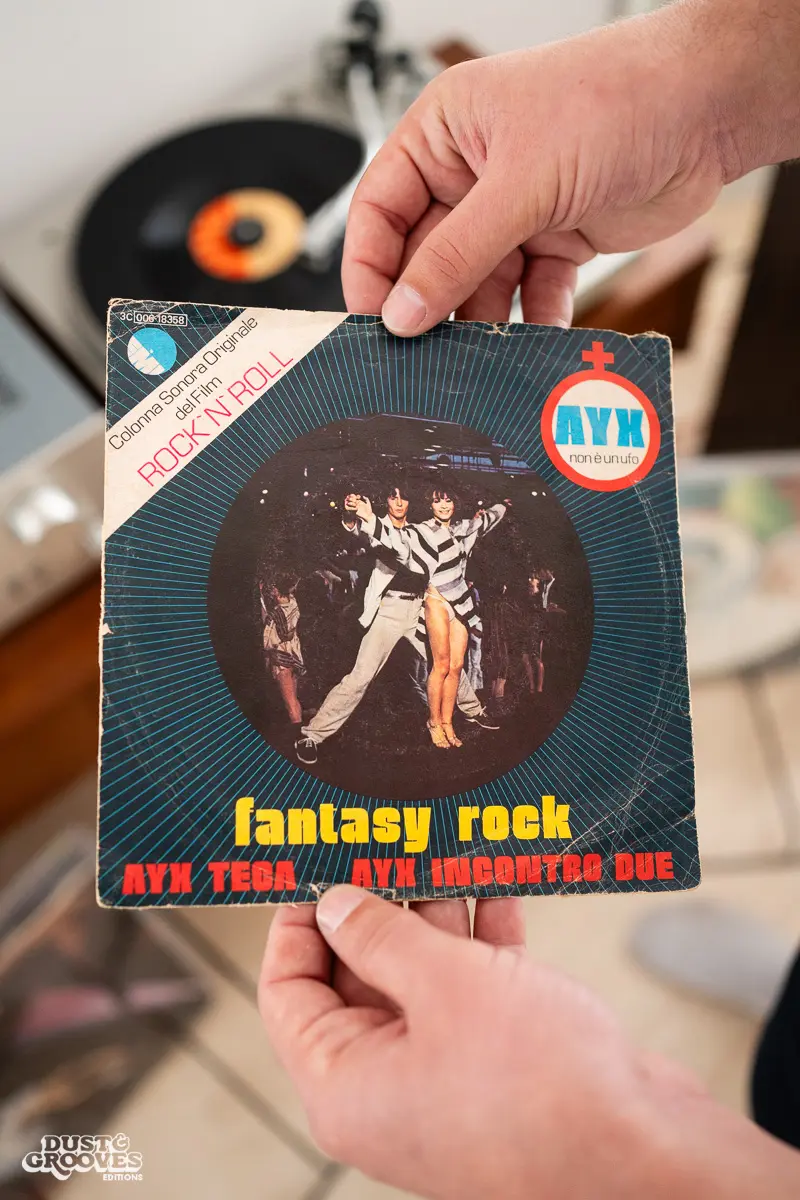
Ayx – “Fantasy Rock”. “The soundtrack of the film Rock ‘n’ Roll, one of the many poorly made disco movies, winked at American films such as La Febbre del Sabato Sera. In Italian cities in the late ’70s, there was a real movement around disco music and discotheques, which were essentially an evolution of the earlier Italian balere. ‘Ayx-teca’ remains a fine example of how Italy looked up to America with admiration while still doing things its own way and with character.”
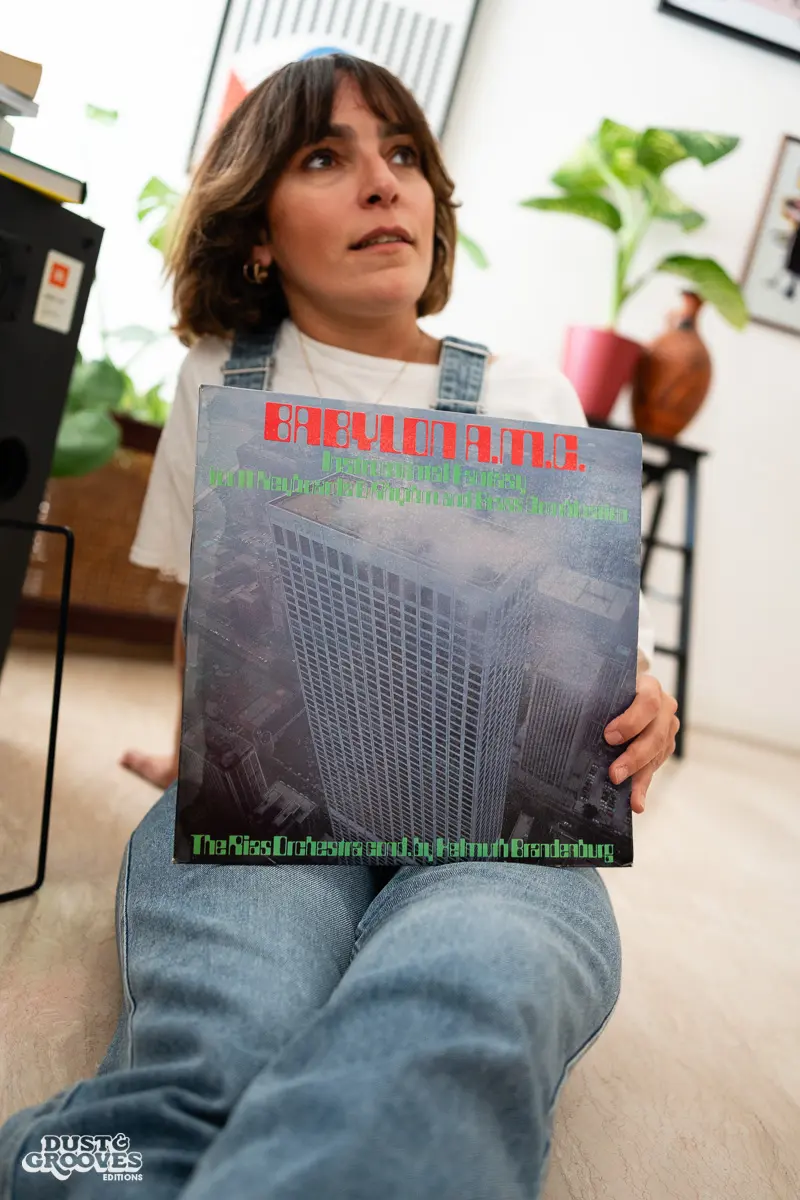
The RIAS Orchestra – Babylon A.M.C.
On a quiet afternoon in Copenhagen’s Reffen neighborhood, after sampling flavors from around the world, we sank into deckchairs by the canal. The gentle murmur of water, the distant hum of the city—and then Babylon A.M.C. – Amram began to play. We fell in love instantly.
This 1978 project by Helmuth Brandenburg and the RIAS Orchestra is a rare gem. Brandenburg, a German composer, arranger, and conductor (1928–2012), led the RIAS Dance Orchestra in the early 1970s and was known for blending orchestral tradition with modern textures. Originally recorded in West Berlin’s RIAS studios as a library or sync project for film and television, it was never meant as a commercial release.
Hearing it there, with the midday light hitting the water, felt like stumbling upon a private soundtrack—ambient, cinematic, and quietly romantic.
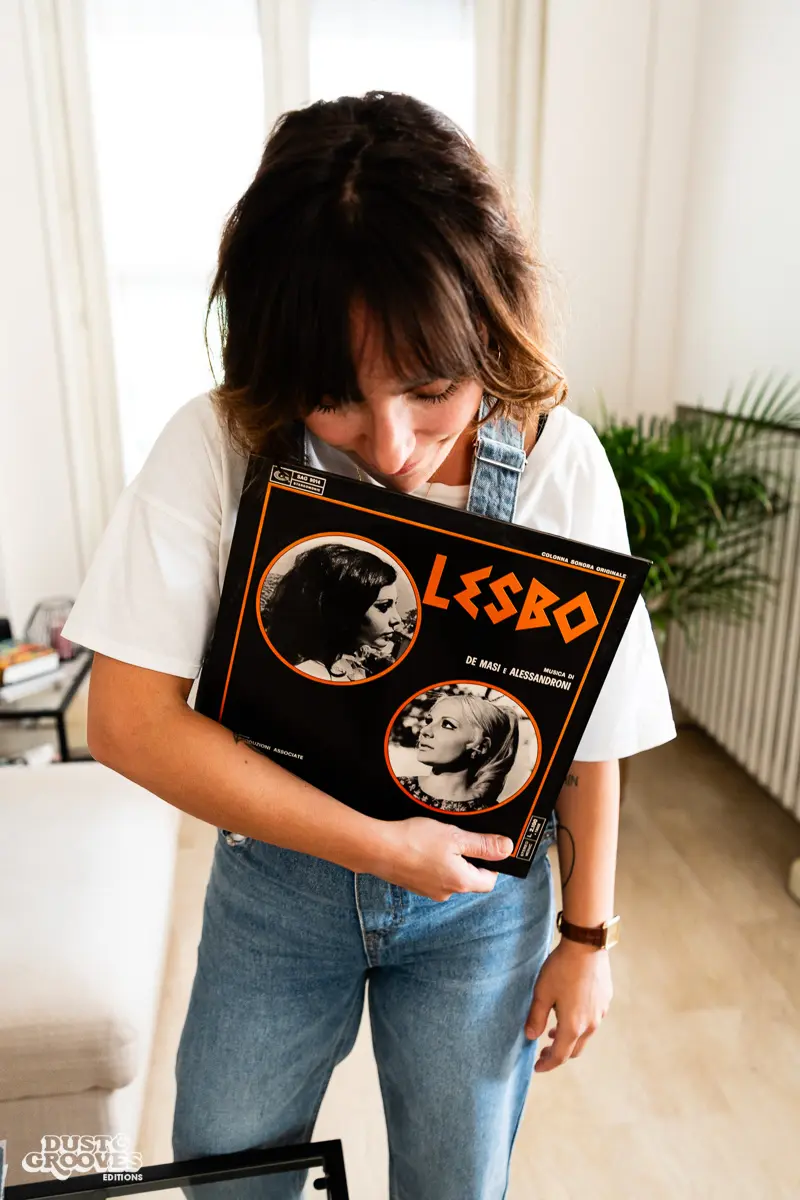
Alessandro Alessandroni – Lesbo. A stunning example of Italian library music at its most sensual and cinematic. Blending jazz, lounge, and experimental textures, it captures that unmistakable late-’60s atmosphere—mysterious, elegant, and slightly surreal. Soundtrack records are like trophies for collectors; this album’s beauty speaks entirely for itself.
What is it like sharing your collection with someone?
It is like tending a small garden. Just as in nature, in our “music room,” our ideas and projects are born. But, it can also seed the paranoia that arises when a record gets lost!
Tell us about a memorable record moment you have had together.
Studio 151 in New York City was a memorable night—playing disco in the home of disco and making everyone dance until 4 AM was unforgettable!
I can imagine playing at Studio 151 would be incredible. What’s your favorite part of DJing for an audience?
DJing for an audience is just the tip of the iceberg of an experience that starts with building the story, the journey you want to tell. A unique and ever-changing story that starts from the desire to express the emotion behind the choice of each record.
We always try to push ourselves beyond our comfort zone when we are behind a DJ booth, often offering lesser known records and experimenting with the listener. The goal is to spread a piece of our research journey each time that makes people break out and open their minds. The most beautiful part starts from the construction of the set by imagining the energy and charm that each individual record can exert up until the realization of it on the dancefloor or in the listening room.
Who would you like to see next on Dust & Grooves?
More than who we’d like to see, what excites us is the idea of exploring where we haven’t gone yet. Imagine Dust & Grooves hitting fresh, underexposed territories—Southeast Asia, Korea or Africa—to uncover new, incredible stories about vinyl collecting. Who knows what unheard records are out there waiting to be discovered? That’s the kind of journey we’d love to take next.
Italian DJs and record collectors, Gio and Vale (Raregems) dig for rare and overlooked vinyl from Latin America, Africa, and Italy. Their collection spans disco, funk, Italo-disco, and experimental sounds, preserving music that often falls outside mainstream recognition.
IG
Further Adventures in Record Collecting
Dust & Grooves Vol. 2
Raregems and 150 other great collectors are featured in the book Dust & Grooves Vol 2: Further Adventures in Record Collecting.
Become a member or make a donation
Support Dust & Grooves
Dear Dust & Groovers,
For over a decade, we’ve been dedicated to bringing you the stories, collections, and passion of vinyl record collectors from around the world. We’ve built a community that celebrates the art of record collecting and the love of music. We rely on the support of our readers and fellow music lovers like YOU!
If you enjoy our content and believe in our mission, please consider becoming a paid member or make a one time donation. Your support helps us continue to share these stories and preserve the culture we all cherish.
Thank you for being part of this incredible journey.
Groove on,
Eilon Paz and the Dust & Grooves team




